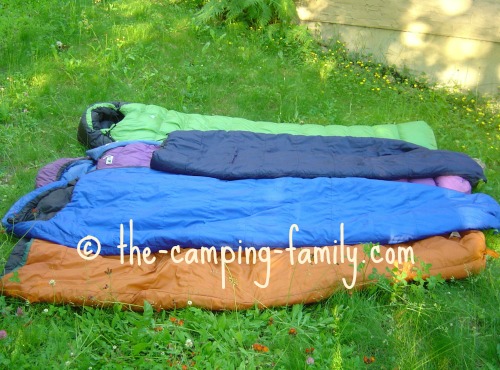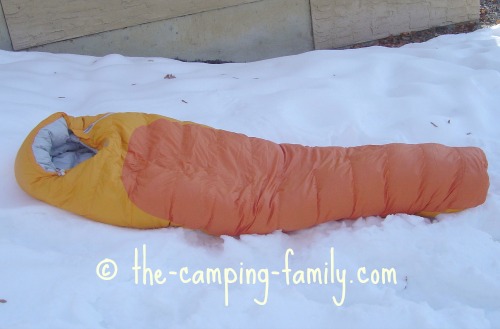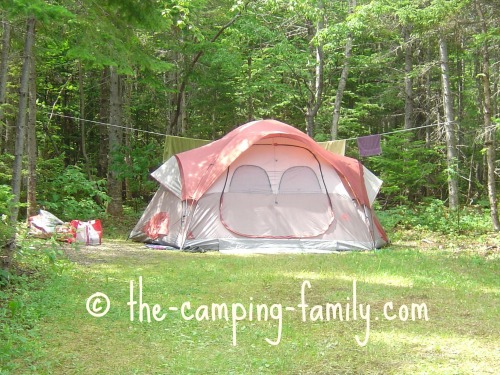Sleeping Bag Ratings
What Do Those Temperature Guidelines
Really Mean?
Sleeping bag ratings are provided by most manufacturers to describe the warmth of their bags. However, these temperature guidelines are sometimes confusing - and they can vary from one company to another.
To add to the confusion, what is comfortable for one person at a certain temperature might be much too cold or warm for another person in the very same conditions.
Let me demystify sleeping bag temperature ratings for you!

Portable Shower for Camping
This portable rechargeable camping shower set means you can shower anywhere!
Read more at Amazon here and find the best price!!
Sleeping Bags rated by season
Some sleeping bag ratings are season-based.
Summer bags
A summer bag can be used at temperatures of about 35 degrees Fahrenheit and above. (That's above 2 degrees Celsius.)

If you will be camping only in the heat of the summer, in locations that don't get too cool at night, this type of bag will work for you.
Three season bags
A three season bag is suitable for temperatures between about +10 and +35 F.
That's -12 to +2 Celsius.

A three season bag is appropriate for many camping families. It will keep you warm on cool summer nights.
Cold weather bags
A cold weather bag can be used for temperatures of between about -10 and +10F.
That's -23C to -12 Celsius.

If you are going to camp in the spring or fall, or at higher altitudes, you'll appreciate the warmth of a cold weather bag.
Click here to learn more about cold weather sleeping bags.
Extreme cold weather bags
An extreme cold weather bag is suitable for temperatures below -10F. (That's -23C.)
Brrrrrr!
Most families won't need this type of sleeping bag.
Sleeping bag ratings by temperature
Other sleeping bag ratings specify the temperature at which the manufacturer thinks the bag should be used.
As a general rule, choose a bag that is rated for lower temperatures than you expect to encounter.
The company may specify a temperature range, or they may give just one number.
Range
If a range is specified (eg 20F to 70F/-6C to +21C), that means that the bag will keep you warm within that temperature range.
It doesn't mean that you can't use the bag if the temperature is above the range. You can always unzip the bag, or lie on top of it.
Number
If just one number is specified (eg -14F/-10C), that is the lowest temperature at which they recommend using the bag.
But that's not all!
The temperature rating is just one piece of information. There is more to know.
Different manufacturers use different standards.
Sleeping bag ratings vary from brand to brand. What one company calls a 0 degree bag might be rated a 10 degree bag by another company.
Respected outdoor equipment companies like Mountain Equipment Coop and REI do rigorous testing of their sleeping bags. I trust their ratings.
In general, I would be less likely to trust the temperature ratings of cheap or "discount" brands.
Individual Differences
People vary widely in their preferred sleeping temperature. (If you've ever shared a bed with someone who kicked off the covers while you struggled to pull the covers back up, you'll know what I mean!)
If you are someone who "sleeps cold", you may want to choose a bag that is rated for even colder temperatures than you expect to encounter.
Other ways to stay warm
Choosing the proper sleeping bag is just part of staying warm while camping. Here are some other factors to consider.
Sleep on a good quality sleeping pad.
The best sleeping bag in the world won't keep you warm if you are lying on the cold ground. A sleeping pad will raise you off the ground and help to keep you warm.
The GAIALOOP Thick Memory Foam Camping Mattress Sleeping Pad is very popular and comes in a variety of colors. With thick memory foam it is very comfortable and supportive, and has a waterproof and washable cover.
For further details and the best price on Amazon CLICK HERE
Here's some more information on camping sleeping pads.
Use a sleeping bag liner.
A liner can make your bag more versatile. Click here to learn how.
Learn about staying warm.
There are lots of things you can do to boost your warmth and comfort. Learn how to stay warm in a sleeping bag here.
Now that you understand sleeping bag ratings for temperature, you're ready to consider the different types of sleeping bags.
Most Popular
Product of the Month
Iwatani Camp Stove
The perfect portable cooktop!
CLICK HERE for more information and best price
Recent Articles
-
Camping Tips For The Best Camping Trip With Your Family
Apr 15, 25 11:21 AM
After years of family camping, we've learned lots of camping tips that make any camping trip easier and happier. Here are our favorites! -
Camping Snacks: Healthy Delicious Treats For Your Next Camping Trip
Apr 15, 25 11:10 AM
Enjoy these healthy camping snacks on your next family camping trip! -
A Portable Camping Toilet Lets You Relax and Enjoy Your Vacation
Apr 15, 25 03:54 AM
Bring along your own camping toilet on your next camping trip and be prepared for anything! Choose the right type of toilet for your family with this simple guide.






